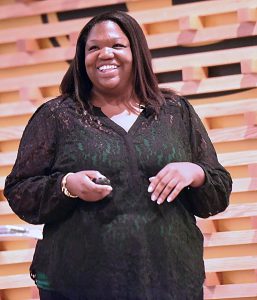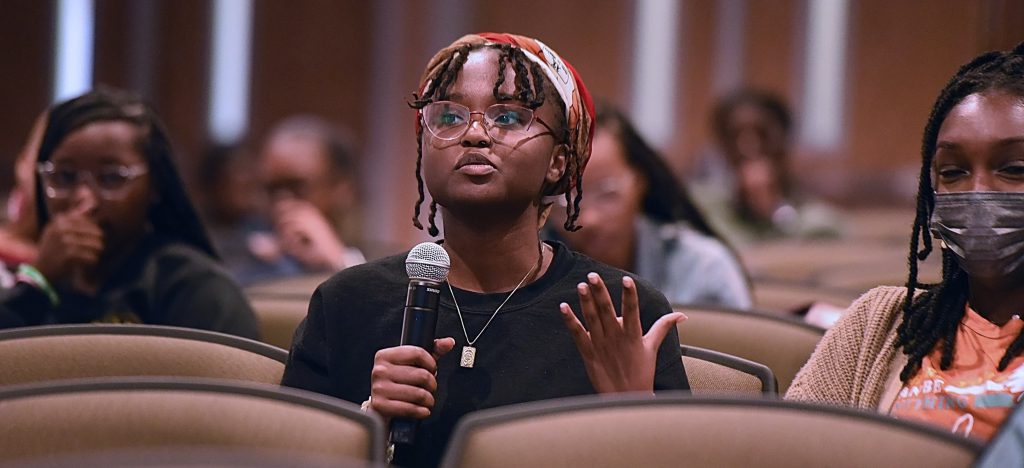Dr. Alicia Odewale shares story of resiliency through anthropological research on 1921 Tulsa Race Massacre
Grambling, La. – November 14, 2022 – Dr. Alicia Odewale, an African Diaspora archaeologist and an assistant professor of anthropology at The University of Tulsa appeared at Grambling State University recently to give a presentation on reanalyzing historical evidence from the 1921 Tulsa Race Massacre. Her work focuses not on the attack itself, but instead on the community’s trauma and triumph in its aftermath.
Dr. Odewale’s session, “Greenwood: A Century of Resilience,” discussed the events that occurred over a span of around 18 hours — from May 31 to June 1, 1921 — when a white mob attacked residents, homes, and businesses in the predominantly Black Greenwood neighborhood of Tulsa, Okla.
Odewale’s research project findings, “Mapping Historical Trauma in Tulsa from 1921-2021,” documented the personal stories of Greenwood’s residents while also mapping the evidence of their resilience.
Most of Tulsa’s 10,000 Black residents in 1921 lived in a neighborhood called Greenwood that included a thriving business district sometimes referred to as the Black Wall Street. Using evidence that surfaced through her research, Odewale gave an in-depth view of the socioeconomic and racial climate and digested encounters that occurred before and after the tragic event.
On May 30, 1921, Dick Rowland, a young Black teenager, entered an elevator at the Drexel Building on South Main Street in Tulsa.
At some point after that, the young white elevator operator, Sarah Page, screamed, and Rowland fled the scene. Police were called to the office building, and the next morning they arrested Rowland.
A front-page story in the Tulsa Tribune the afternoon of May 30, 1921, reported that police had arrested Rowland for sexually assaulting Page.

By the time evening fell, a mob of whites had gathered outside the courthouse, demanding the sheriff hand over Rowland. Sheriff Willard McCullough refused, and his men barricaded themselves on the top floor of the Sheriff’s Office to protect the Black teenager.
Around 9 p.m. that evening, a group of about 25 armed Black men — including many said to be World War I veterans— went to the courthouse and offered help guarding Rowland but were turned away by the sheriff.
Soon afterward, some of the white mob is said to have unsuccessfully tried to break into the National Guard armory nearby.
When a group of around 75 armed Black men returned to the courthouse around 10 p.m., they were met by an estimated 1,500 white men, some of whom were armed. The group of Black men then retreated to Greenwood after shots broke out at the courthouse.
After a night of unrest, including the shooting of an unarmed Black man in a movie theater, thousands of white citizens at the break of dawn poured into the Greenwood District, looting and burning homes and businesses over an area of 35 city blocks. Firefighters who arrived to help put out fires later
“The first shots were fired at 10 p.m. on May 31, 1921, 1,256 homes were looted by the white mob and burned to the ground,” Odewale told those in attendance during the presentation.
“In 1921, the death toll was listed at 36. Today, it is said approximately more than 300 people were murdered.”
During the decades that followed, Odewale said not only were there no effort made to commemorate the events of the event, there were instead deliberate efforts to cover them up by news media and public school systems.
 Odewale also spoke of the resilience and perseverance of those who survived the event and their families.
Odewale also spoke of the resilience and perseverance of those who survived the event and their families.
“Greenwood was determined to rebuild,” Odewale said, “In spite of all that, Greenwood still came back bigger and better than it was before.”
GSU student Lescia Valmond, a biology and history double major from Dominica, felt engaged enough by the presentation that she also attended another talk Odewale gave to an African American History class later Monday afternoon.
“She was very articulate about her presentation and relied on facts,” Valmond said. “A lot of times when Blacks talk about Black history, many people believe their talk is based on only sentiment. But her presentation was based on evidence of what she’s researched. She’s not just putting out falsified information. She’s put out factual numbers to back up what she’s saying.”
Valmond admitted she had read quite a bit about the event before hearing Odewale’s presentation.
“There were still a lot of new things she said I did not know exactly because the worldwide web does not provide as much information as to the geography and the exact people involved,” Valmond said. “She touched on several gray areas and with the visualization she provided so that we could see what happened, that was the part I loved the most.”
In a post-event interview, Dr. Odewale expressed that she hopes her presence at Grambling State provided students with a real view of personal resilience and defying fears to blaze a different trail.
“You can follow whatever you want to do, even if it’s something no one else is doing,” Odewale said. “Even if it’s something that people who like you don’t normally do. If you have an interest in it, maybe God put that in your heart for a reason and it’s something you can pursue, even if you might be the first one to blaze that trail.”

